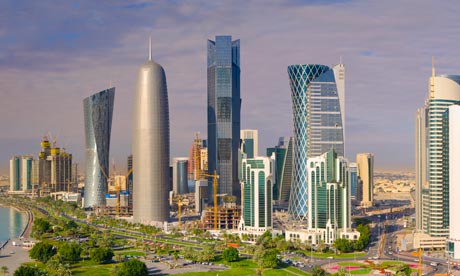The Driving Test.
Having gone through months of confusion, finally taking and passing the signals test, and managing the bizarre engine test, the next and final step was the driving test. That, of course, was the most important.
I heard many different things from friends around Doha on what to expect of the evaluation, and most of what they said had me fairly concerned. Some spoke of a course through which I would have to demonstrate various parking methods (at least two of which are unnecessary), driving through crazy roundabouts, etc. Others had claimed that "no one passes on the first try," which would be unfortunate as I didn't have a lot of free time in the mornings to head out to the Gulf Driving School a few times to try and fail the test. Needless to say, I expected my ordeal was nowhere close to completion.
Fortunately, little of what I had been told held true.
First, Americans who have a current driver's license (that can be shown to the Traffic Department and/or the driving schools) do not need to do the separate parking test (so, if you fall into that category, make sure they send you straight to the road test, not the driving test, which is actually a parking test; italics). While I was not aware of that the day I went, the people in charge fortunately did.
Following success in the signals and engine tests, I was given an appointment at 5:30 AM. While I hate mornings, my driver got me there right on time. As before, no one was present to direct me anywhere. In fact, the whole place looked almost abandoned. I wandered around for a bit until I found someone who, checked me in. Carry cash with you, as you will have to pay yet another superfluous fee: to rent the car you will be driving for the test ("seriously?" is what I almost said to him, "y'all own the car..."). I was then directed to wait.
Be prepared to wait.
An hour went by, then another. I started worrying I had gone to wait in the wrong place. I found the guy who checked me in, and he said I was in the right place. Over two hours had passed. I was convinced by that point that I had somehow missed my call. By then I was wandering about, asking anyone who understood English as to when the tests would start. No one knew (most didn't understand what I was asking). It was quite disconcerting.
Finally, two and a half hours later, they began calling names for road tests. After another hour and thirty minutes, my name was called.
After some confusing directions, I found the car waiting in the compound. A guy was already in the driver's seat, with both hands on the wheel, looking as though he had just been informed that the car was rigged to explode should he move at all. A Jordanian man who also held American citizenship was the third in our car. He and I chatted for a bit, and then we turned to the nervous guy and learned that it was his fourth try. That didn't feel very encouraging.
Once the official who evaluated us arrived, we departed the compound for the streets of the Old Airport District. Right, straight, take a u-turn, right again. The first guy was done in less than twenty minutes. He hardly engaged in all varieties of driving action. I was somewhat heartened by it. Next was the Jordanian. His went about the same, although instead of a u-turn, he went through a couple one-land roundabouts.
Then my turn. It nearly started in disaster. Admittedly, I was a bit nervous. I hopped in the driver's seat, adjusted the mirrors, moved the seat, almost everything one is expected to do before pulling out on to the road. The official didn't see me adjust my mirrors, however, and so he asked "don't you think you should check your mirrors?" So I feigned "not having gotten to them yet." I re-readjusted the mirrors. Looked for any coming traffic, and prepared to pull onto the road. I then realized I had forgotten to fasten my seat-belt -- narrowly avoided that one. The test itself was done in fifteen minutes. Back to the driving school's compound and we were done.
Then, more waiting -- to hear if I had passed. By about 10:00, they began going through the names. More failed than passed, which caused a bit of anxiety. But then, "Mahk Glahsen...pass."
Then, more waiting -- to get the license. Once nice thing is that you can take the tests and get the physical license all in the same place. After about twenty or thirty minutes I had the card in hand and was headed back to work.
Despite the angst and annoyance, and two months of having no idea what I was supposed to really do, I finally got the license. Once again, a permitted driver.
And while one episode concluded, another began. I had the license, but what was I to drive?
































